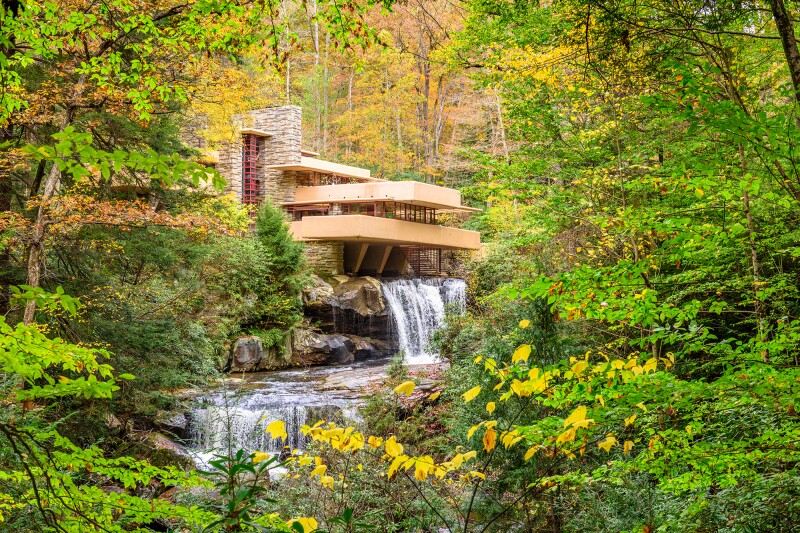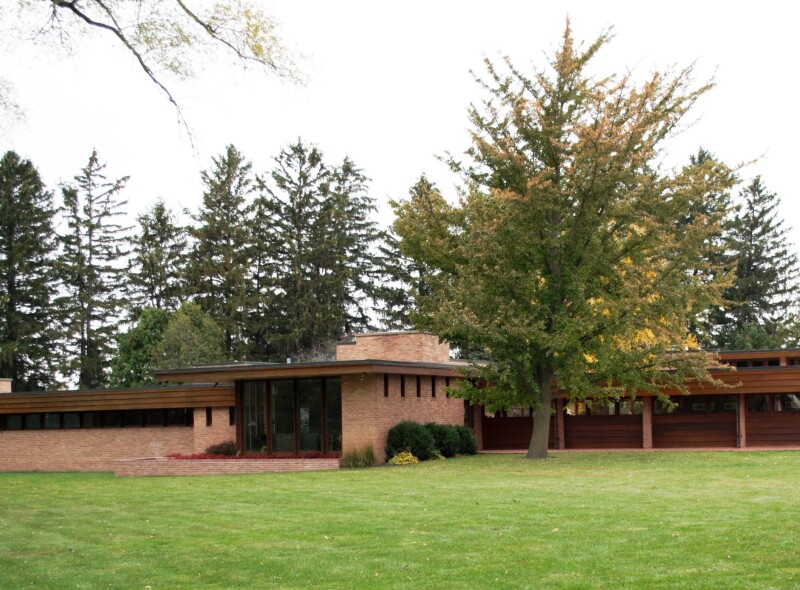Frank Lloyd Wright revolutionized American architecture. Before him, the pinnacle of luxury was owning a European-inspired home: think French Empire, Italianate, and Gothic revival. Wright, who began working as a draftsman in 1887, changed all of that with his designs, which today look delightfully retro. Throughout his seven-decade-long career, he designed more than 1,000 buildings. Today, he’s recognized as one of the most accomplished architects of all time. Although he created a number of famous public buildings, such as New York City’s Guggenheim Museum, Wright primarily worked with private homeowners to create the homes of their dreams—and his too.
He is perhaps best known for pioneering the prairie-style house, characterized by its dramatically flat cantilevered roofs, neutral colors, minimalist aesthetics, and simple but striking silhouettes. Inspired by the open, flat expanse of the American prairie, Wright’s designs sensationalized both the interior and home design worlds. In his later years, Wright became inspired by both Japanese and pre-Columbian architecture, influences that would dominate the work he created.
Of the 400 Frank Lloyd Wright houses that are still standing, roughly two-thirds are privately owned. A handful are open for visits, from Buffalo all the way to Palo Alto. Read on for 12 Frank Lloyd Wright homes you can tour.

Taliesin West, Wright’s winter home and studio starting in 1937, was named after his Taliesin studio in Spring Green, Wisconsin.
Photo by Carrie A Hanrahan/Shutterstock
1. Taliesin West
- When: Monday through Thursday; tours start at 9 a.m. (8 a.m. on Saturdays), with the last tour at 10:45 a.m. (11:45 a.m in September).
- Where: Scottsdale, Arizona
- Visit: Tickets start at $49, franklloydwright.org
Wright began traveling to the Southwest in the mid-1930s to escape the harsh Midwestern winters. Once there, he purchased several hundred acres of desert land about 26 miles outside of Scottsdale and established Taliesin West, so named for his Taliesin studio in Spring Green, Wisconsin. Until his death in 1959, this Arizona house served as his winter home and an education center where he would instruct students. Inspired by the desert landscape, Wright chose to construct Taliesin West out of native rock, cement mixed with local materials, and Arizona sand. With its low-slung silhouette framed by redwood beams, Wright intended to create a structure that blended neatly into the environment. Today, Taliesin has been reinforced with longer-lasting materials like steel and fiberglass, but it remains an interesting stop on any FLW itinerary and is the home base of the Frank Lloyd Wright Foundation. Note that Taliesin West is open only in the mornings for tours, either with an audio guide or a docent.

The Rosenbaum House is the only Frank Lloyd Wright–designed building in Alabama.
Photo by Tim Daugherty/Shutterstock
2. Rosenbaum House
- When: Tuesday–Saturday 10 a.m. to 4 p.m., Sunday 1 p.m. to 4 p.m. (last tour at 3:15 p.m.)
- Where: Florence, Alabama
- Visit: Tickets $10 ($5 for seniors and students), wrightinalabama.com
The Rosenbaum House, the only Wright-designed home in Alabama, is considered to be the purest incarnation of his Usonian style, with simple, utilitarian design that could be affordable to middle-class Americans. The house was commissioned by newlyweds Stanley and Mildred Rosenbaum, who moved there in 1939 and immediately ran into a leaky roof and failing in-floor heating. Still, the Rosenbaums stayed in the house—asking Wright to design an addition as their family grew. After Mildred passed away in 1999, the city of Florence acquired the house, which it then converted into a museum.
Rosenbaum House was built in a classic L-shape with built-in furniture and, adhering to Wright’s minimalist tendencies, doesn’t have an attic or basement. With its floor-to-ceiling windows and neutral-colored building materials, the structure blurs the line between the house and its surroundings.

Hollyhock House is a fantastic example of Wright’s pre-Columbian era.
Photo by Joshua WhiteJWPictures.com, courtesy of Hollyhock House
3. Hollyhock House
- Where: East Hollywood, Los Angeles
- When: Thursday–Saturday, from 11:00 a.m. to 4:00 p.m.
- Visit: Tickets $12 ($6 for seniors and students, under 18 free with paying adult), hollyhockhouse.org
Commissioned by oil heiress, philanthropist, and socialite Aline Barnsdall, Hollyhock House was built over two years—from 1919 to 1921—in the East Hollywood neighborhood of Los Angeles. Hollyhock was constructed during a rather tumultuous time in Wright’s life. His partner, Mamah Borthwick, was brutally murdered in 1914, and Wright then moved to California.
After Borthwick’s death, Wright’s style took a rather severe turn and gravitated toward pre-Columbian-influenced design: think imposing Mayan temples, Aztec symbology, and lots of concrete blocks. With “inverted” windows (which aren’t visible from the outside), Mayan revival–style roof decor, a cryptic bas-relief mantelpiece, and even a moat, Hollyhock House is a fantastic example of the enigmatic style Wright adopted during his time in Los Angeles.
According to a New York Times article from 1984, Barnsdall lived here with her daughter Betty and their 12 (yes) dogs, but she found it difficult to live in and deeded it to the city in 1926. In 2019, Hollyhock House, as part of the The 20th-Century Architecture of Frank Lloyd Wright, joined the UNESCO World Heritage list.

The Hanna-Honeycomb House, part of Stanford University, is open only twice a year.
Courtesy of Thomas Hawk/Flickr
4. Hanna-Honeycomb House
- When: Open twice a year
- Where: Stanford, California
- Visit: Free, hannahousetours.stanford.edu
The Hanna-Honeycomb House, so named because of its hexagonal structure, was Wright’s first work in the Bay Area and the first nonrectangular building he designed. Construction began in 1937 and, over the next 25 years, Wright continued to adapt and expand the house. Like the Rosenbaum House in Alabama, this one is considered a prime example of Wright’s Usonian style of architecture, even though it has many extra bells and whistles (garden house, double garage, hobby shop) that would push it beyond the reach of the average home buyer. It was originally built for professors Jean and Paul Hanna, who lived with their three children in the house for 38 years until they donated it to Stanford University in 1975.
Getting a peek inside this Wright creation can be tricky. The Hanna-Honeycomb house is open only twice a year for public tours. You can email the Stanford Historical Society to find out when the next tour will be.

The Robie House is considered to be the definitive prairie-style home.
Courtesy of Teemu008/Flickr
5. Frederick C. Robie House
- When: Open Thursday–Monday from 10 a.m. to 2:30 p.m.
- Where: Hyde Park, Chicago
- Visit: Tickets from $24, flwright.org
Located in Chicago’s ritzy Hyde Park neighborhood, the Robie House is considered to be the definitive prairie-style home. With a cantilevered roof and exaggerated overhanging eaves, the building is a brick and concrete ode to the utterly flat beauty of the open plains. Its delightfully airy open floor plan was a bold choice when it was completed, at a time when contemporary house design favored a maze of walls and rooms. It was completed in 1910 for businessman Frederick C. Robie, although he lived in the house for just 14 months before being forced to sell it due to financial troubles. The building was nearly demolished twice (in 1941 and 1957), but Wright campaigned to save it—the only times he ever intervened to rescue one of his designs. However, the unique abode eventually got the acknowledgment it deserved and, in 1991, was recognized by the American Institute of Architects as one of the most important structures created during the 20th century. Today it sits on the campus of the University of Chicago, which opened 20 years before the house was built.

Pennsylvania’s Fallingwater house is one of eight Frank Lloyd Wright buildings added as a group to the UNESCO World Heritage list.
Photo by Sean Pavone / Shutterstock
6. Fallingwater
- When: Open Thursday–Tuesday from 8 a.m. to 4 p.m.
- Where: Mill Run, Pennsylvania
- Visit: Tickets from $39, fallingwater.org
Besides the Guggenheim Museum, Fallingwater may be the most famous building Wright created. It’s considered the peak manifestation of his concept of organic architecture. He believed that there could be a harmonious, beneficial relationship among people, art, and nature. Fallingwater, in Pennsylvania’s hilly Laurel Highlands, is perched above a tranquil waterfall and was built with locally quarried sandstone. Its construction was completed in 1939, and the Kaufmann family (who owned the Kaufmann’s Department Store in Pittsburgh) used it as a vacation home until they donated the property and 1,500 acres of land to the Western Pennsylvania Conservancy in 1963. Today, Fallingwater is a UNESCO World Heritage site, hailed as the “best all-time work of American architecture” by the American Institute of Architects.

Cedar Rock is sited on a limestone bluff above the Wapsipinicon River.
Photo by Iowa DNR, Cedar Rock Archives, Doug Carr
7. Cedar Rock (Lowell Walter House)
- When: Mid-May to early October, Wednesday–Sunday from 10 a.m. to 3 p.m.
- Where: Independence, Iowa
- Visit: Free, iowadnr.gov
This dreamy abode encompasses 1,800 square feet of pure FLW design. Wright oversaw every detail within Cedar Rock, right down to the cups and plates that graced the dinner table. Tour guides here say that the only thing allowed on the property that wasn’t designed by Wright was a Thompson TVT boat, a small, wooden runabout. The home was designed for the Walter, who had become wealthy asphalting rural roads. Cedar Rock has a completely flat roof, brick walls, floor-to-ceiling windows aplenty, and concrete floors. Following Lowell Walter’s death in 1981, the home was donated to the state of Iowa, which still maintains the property.

Made of local sandstone and red cypress, and with its low-slung profile, Kentuck Knob blends into the surrounding landscape.
Photo by Alex Byers, courtesy Kentuck Knob
8. Kentuck Knob
- When: March 15–November 2, 9 a.m. to 4 p.m. daily (from noon on Wednesdays); until November 29, 10 a.m. to 3 p.m. daily (from noon on Wednesdays); in December, weekends from 10 a.m. to 3 p.m.
- Where: Dunbar, Pennsylvania
- Visit: Tickets from $30 ($18 for students ages 6 and up), kentuckknob.com
Commissioned by Bernadine and I. N. Hagan, friends of Fallingwater owners the Kauffmanns, Kentuck Knob was one of the last homes that Wright built—he was 86 years old when he agreed to take on the project. Although Usonian in design, this house has an unusual hexagonal structure. Built with local sandstone and North Carolinian red cypress, the structure’s low-slung profile blends gracefully into the landscape. Why is a house in Pennsylvania called the “Kentuck Knob”? The name was inspired by the property it’s built on. It’s alleged that an 18th-century settler named David Askins was considering moving to Kentucky from Pennsylvania, but decided instead to settle in the Quaker State’s southwestern corner and dubbed it Little Kentuck.

Wright designed his private home and studio in the popular, East Coast shingle style.
Courtesy of xiquinhosilva/Flickr
9. Frank Lloyd Wright Home and Studio
- When: Daily 10 a.m. to 4 p.m.
- Where: Oak Park, Chicago
- Visit: Tickets from $24, flwright.org
In 1889, when Wright was 22 and freshly married, he borrowed $5,000 (about $175,00 today) and built this home and studio. It was the first time he would have complete creative control over a project and was the kickoff to his career. Wright designed his house in the shingle style, a then-popular East Coast design characterized by an asymmetrical facade, large veranda, and wood shingles.
Despite being one of his earliest works, the home showed signs of Wright’s clever revolutionary design. His house and studio were one of the first instances where he bucked the Victorian compartmentalized layout of a home and instead opted for an open-concept layout. Wright would expand and renovate the property twice during the 20-odd years that he lived there, pioneering his iconic prairie style of design in the home studio.

Elizabeth and Robert Muirhead commissioned Wright to design their house after visiting his Wisconsin studio, Taliesin, in 1948.
Courtesy of Muirhead Farmhouse
10. Muirhead Farmhouse
- When: Open select dates from May through October
- Where: Kane County, Illinois
- Visit: Tickets are $35 per person, private tours cost $200 plus $35 per person, muirheadfarmhouse.com
About a 90-minute drive from Chicago is Muirhead Farmhouse. It’s the only farmhouse Wright ever designed, and it’s probably unlike any other you’ve seen. Clocking in at 3,200 square feet and surrounded by 1,100 acres of wetlands, grasses, and native prairie wildflowers, the almost-ranch-style house is distinctly boxy and sprawls across the property.
Wright built this Usonian-style home out of Chicago brick, concrete mixed with local materials, and tidewater red cypress. Completed for Robert and Elizabeth Muirhead in 1953, the property remains in the family to this day and underwent an extensive renovation in 2003.

Built for an unusually tall Louis Penfield, this Ohio home is unique; Wright preferred low-slung entryways but adjusted the doorways in this house to accommodate its owner.
Courtesy of GPA Photo Archive/Flickr
11. The Louis Penfield House
- When: Open to overnight guests
- Where: Willoughby Hills, Ohio
- Visit: Two-night minimum; rates start at $450 (Monday–Thursday ), $500 (Friday–Sunday)
The Louis Penfield House, one of nine Usonian-style homes Wright built in Ohio, is 20 minutes east of downtown Cleveland. The home was created for Pauline Penfield and her husband, Louis, who stood at six feet eight inches. Upon meeting Louis, Wright is said to have exclaimed, “Anyone that tall is a weed. We’ll have to build a machine to tip you sideways!” The structure, completed in 1955 and set on 30 sprawling acres, overlooks the Chagrin River and is painted a cream color with red accents. The home is one of only a handful available to rent for overnight stays. Its three bedrooms and one and a half bathrooms can accommodate up to five people.

After being abandoned for decades, Martin House was carefully restored and opened to the public in 2019.
Courtesy of Warren LeMay/Flickr
12. Martin House
- When: Daily 9 a.m. to 4:30 p.m. (5 p.m. on weekends)
- Where: Buffalo, New York
- Visit: Tickets from $25 (seniors $23, students $10)
Western New York has a solid concentration of FLW houses, and while not all are open to the public, you can still drive by. One superb house you can visit is Martin House, a massive, nearly 15,000-square-foot abode completed in 1905. A Usonian-style home this was not; in addition to the Martins’ manse with its handsome built-ins, art glass windows, and a double-sided fireplace, the sprawling property also has a gardener’s cottage, pergola, conservatory, and a 5,000-square-foot carriage house. Martin House today is pristine, but for years it stood in a state of neglect, abandoned and even partially demolished. Restoration efforts kicked off in 1992, and finally, in 2019, it emerged as beautiful as ever.
This article was originally published in 2022 and most recently updated on July 14, 2025, with current information. Sophie Friedman contributed to the reporting of this story.











